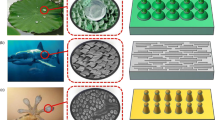Abstract
Surface texture patterns have great potential for improving tribological performance in terms of reducing friction and wear. The most common methods for surface texturing are laser and injection molding. The 3D printing method is also used to build parts, patterns, and molds that feature fine details for a wide range of applications because texture manufacturing by 3D printing is faster, more flexible, and less expensive than traditional techniques. To date, there has been no research on textured surfaces produced by 3D printing. Therefore, a new fabrication method using 3D printing to improve friction and wear properties is a topic worth exploring. In this study, a reciprocating friction tester was used to evaluate the friction and wear properties of different surface textures produced by 3D printing. The surface of specimens was examined by electron microscope and scanning electron microscope before and after the test. The results show that surface texturing can be applied to 3D printed parts to improve their friction and wear performance.
Similar content being viewed by others
References
Etsion I. Improving tribological performance of mechanical components by laser surface texturing. Tribol Lett, 2004, 17: 733–737
Erdemir A. Review of engineered tribological interfaces for improved boundary lubrication. Tribol Int, 2005, 38: 249–256
Etsion I. State of the art in laser surface texturing. J Tribol, 2005, 127: 248–253
Wu W, Shao T M, Chen G M. Influence of groove surface texture on temperature rise under dry sliding friction. Sci China Tech Sci, 2016, 59: 183–190
Pettersson U, Jacobson S. Friction and wear properties of micro textured DLC coated surfaces in boundary lubricated sliding. Tribol Lett, 2004, 17: 553–559
Pettersson U, Jacobson S. Influence of surface texture on boundary lubricated sliding contacts. Tribol Int, 2003, 36: 857–864
He B, Chen W, Wang Q J. Surface texture effect on friction of a microtextured poly(dimethylsiloxane) (PDMS). Tribol Lett, 2008, 31: 187–197
Shi X, Ni T. Effects of groove textures on fully lubricated sliding with cavitation. Tribol Int, 2011, 44: 2022–2028
Cho M. Friction and wear of a hybrid surface texturing of polyphenylene sulfide-filled micropores. Wear, 2016, 346–347: 158–167
Wang R, Bai S X. Influence of laser geometric morphology type on SiC surface wettability. Sci China Tech Sci, 2016, 59: 592–596
Korpela T, Suvanto M, Pakkanen T T. Wear and friction behavior of polyacetal surfaces with micro-structure controlled surface pressure. Wear, 2015, 328–329: 262–269
Yin H Q, Jia C C, Qu X H. Micro powder injection molding—Large scale production technology for micro-sized components. Sci China Ser E-Tech Sci, 2008, 51: 121–126
Armillotta A. Assessment of surface quality on textured FDM prototypes. Rapid Prototyping J, 2006, 12: 35–41
Jo W, Kim D H, Lee J S, et al. 3D printed tactile pattern formation on paper with thermal reflow method. RSC Adv, 2014, 4: 31764–31770
Singh Boparai K, Singh R, Singh H. Wear behavior of FDM parts fabricated by composite material feed stock filament. Rapid Prototyping J, 2016, 22: 350–357
Ou J, Dublon G, Cheng C Y, et al. Cilllia: 3D printed micro-pillar structures for surface texture, actuation and sensing. In: Proceedings of the 2016 CHI Conference on Human Factors in Computing Systems. ACM, 2016. 5753–5764
Vorndran E, Klammert U, Ewald A, et al. Simultaneous immobilization of bioactives during 3D powder printing of bioceramic drug-release matrices. Adv Funct Mater, 2010, 20: 1585–1591
Stansbury J W, Idacavage M J. 3D printing with polymers: Challenges among expanding options and opportunities. Dental Mater, 2016, 32: 54–64
Sachs E, Curodeau A, Gossard D, et al. Surface texture by 3D printing. In: Proceedings of Solid Freeform Fabrication Symposium. 1994. 56–64
Snyder T, Mick J, Weislogel M, et al. Single-build additive manufacturing of autonomous machines. In: Proceedings of NIP & Digital Fabrication Conference. Soc Imaging Sci Techl, 2015. (1): 293–298
Ge S, Wang Q, Zhang D, et al. Friction and wear behavior of nitrogen ion implanted UHMWPE against ZrO2 ceramic. Wear, 2003, 255: 1069–1075
Xiong D S. Friction and wear properties of UHMWPE composites reinforced with carbon fiber. Mater Lett, 2005, 59: 175–179
Zhang B, Huang W, Wang J, et al. Comparison of the effects of surface texture on the surfaces of steel and UHMWPE. Tribol Int, 2013, 65: 138–145
Li J, Zhou F, Wang X. Modify the friction between steel ball and PDMS disk under water lubrication by surface texturing. Meccanica, 2011, 46: 499–507
Spence D A. The hertz contact problem with finite friction. J Elasticity, 1975, 5: 297–319
Mohrbacher H. The tribological behaviour of advanced hard coatings under fretting conditions. Dissertation for Doctoral Degree. Belgium: KU Leuven, 1995
Koshal D. Manufacturing Engineer’s Reference Book. Avon: Bath Press Ltd, 1993. 2: 15–21
Argade G R, Kandasamy K, Panigrahi S K, et al. Corrosion behavior of a friction stir processed rare-earth added magnesium alloy. Corrosion Sci, 2012, 58: 321–326
Author information
Authors and Affiliations
Corresponding author
Additional information
This work was supported by the Basic Science Research Program of the National Research Foundation of Korea (NRF) funded by the Ministry of Education, Science and Technology of the Korean government (Grant No. NRF-2015R1D1A1A09060901) and Ministry of Trade, Industry and Energy via FY 2015 Korea Institute for the Advancement of technology through Construction Machine R&D Expert Cultivation Program.
Rights and permissions
About this article
Cite this article
Hong, Y., Zhang, P., Lee, KH. et al. Friction and wear of textured surfaces produced by 3D printing. Sci. China Technol. Sci. 60, 1400–1406 (2017). https://doi.org/10.1007/s11431-016-9066-0
Received:
Accepted:
Published:
Issue Date:
DOI: https://doi.org/10.1007/s11431-016-9066-0




